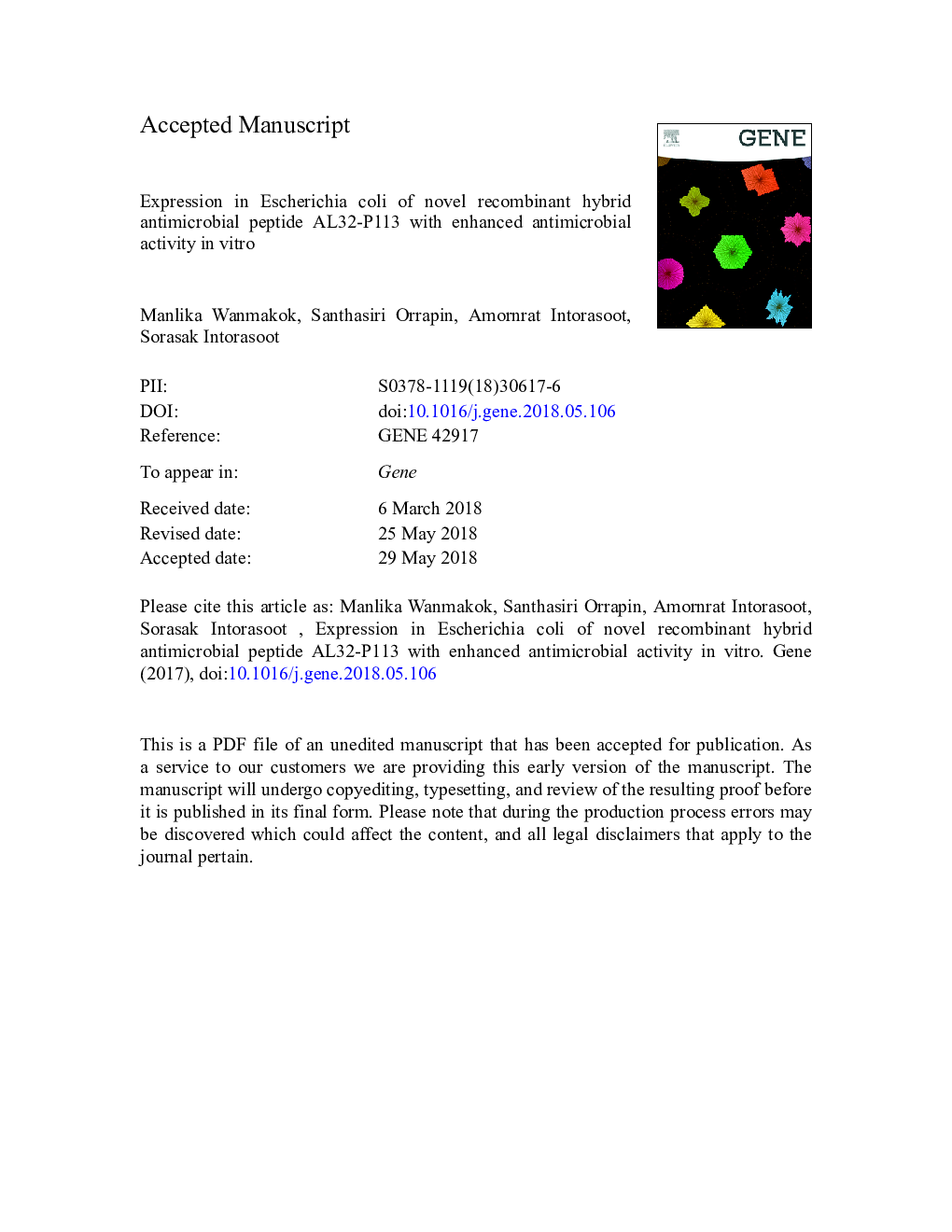| کد مقاله | کد نشریه | سال انتشار | مقاله انگلیسی | نسخه تمام متن |
|---|---|---|---|---|
| 8644663 | 1569765 | 2018 | 47 صفحه PDF | دانلود رایگان |
عنوان انگلیسی مقاله ISI
Expression in Escherichia coli of novel recombinant hybrid antimicrobial peptide AL32-P113 with enhanced antimicrobial activity in vitro
دانلود مقاله + سفارش ترجمه
دانلود مقاله ISI انگلیسی
رایگان برای ایرانیان
کلمات کلیدی
IBCNusABCCPAMPsCLSIPBS-TMICGSTIPTGSUMOMHb - MHBSDS-PAGE - الکتروفورز ژل پلی آکریل آمیدSodium dodecyl sulfate polyacrylamide gel electrophoresis - الکتروفورز ژل پلی اتیل آمید سدیم دودسیل سولفاتisopropyl-β-d-galactopyranoside - ایزوپروپیل بتا-گالاکتوپیرانوزیدMinimum inhibitory concentration - حداقل غلظت مهاریAntimicrobial activity - فعالیت ضدمیکروبیMueller-Hinton broth - مولر-هینتون بوثهbiotin carboxyl carrier protein - پروتئین حامل بیوتین کربوکسیلHybrid peptide - پپتید هیبریدAntimicrobial peptide - پپتیدهای ضدمیکروبیsmall ubiquitin-like modifier - کوچک مانند ubiquitin مانند اصلاح کننده
موضوعات مرتبط
علوم زیستی و بیوفناوری
بیوشیمی، ژنتیک و زیست شناسی مولکولی
ژنتیک
پیش نمایش صفحه اول مقاله

چکیده انگلیسی
Antibiotic-resistant pathogens have become a major public health problem worldwide. New discoveries and strategies as regards antibiotic drug development are urgently in need for curing infected patients. Antimicrobial peptides (AMPs) are short cationic peptides that play important roles in innate immune system with a broad spectrum of antimicrobial activity. Recently, hybrid AMPs have been reported to increase antimicrobial activity, stability, and in vivo half-life. In the present study, a gene encoding for AL32-P113 hybrid peptide consisting of two truncated active forms of human LL-37 and histatin-5 (Hst-5) was commercially constructed, cloned into pTXB-1 commercial plasmid, and expressed in E. coli BL21 (DE3). To increase the yield of target protein expression, IPTG concentration, time and temperature were optimized. The results indicate that AL32-P113-intein fusion protein with 33.7â¯kDa was expressed mostly in inclusion form and estimated to be 20% of the total protein. After chitin affinity purification, 5.7-kDa of AL32-P113 peptide was separated with an average concentration of 12.1â¯mgâ¯perâ¯litre of bacterial culture and over 86% purity. The minimum inhibitory concentration (MIC) was evaluated for antimicrobial activity determination of recombinant AL32-P113 compared to synthetic peptides, LL-37, Hst-5, and L31-P113. The results implied that both hybrid peptides exhibited potent antimicrobial activity against gram-negative bacteria and yeast cells whereas the L31-P113 peptide possessed approximately four times greater antimicrobial activity in gram-positive bacteria than parent LL-37. An increasing of undesired hemolysis of these hybrid peptides toward human red cells was also observed when red blood cell hemolytic assay was performed. Several factors including charge and secondary structure predicted by public software were utilized for explanation of the antimicrobial potency of both hybrid peptides. This study proved that hybrid peptides show broader and more potent antimicrobial ability against pathogens and they could be applied as a therapeutic approach for topical treatment of microbial infection in the future.
ناشر
Database: Elsevier - ScienceDirect (ساینس دایرکت)
Journal: Gene - Volume 671, 10 September 2018, Pages 1-9
Journal: Gene - Volume 671, 10 September 2018, Pages 1-9
نویسندگان
Manlika Wanmakok, Santhasiri Orrapin, Amornrat Intorasoot, Sorasak Intorasoot,